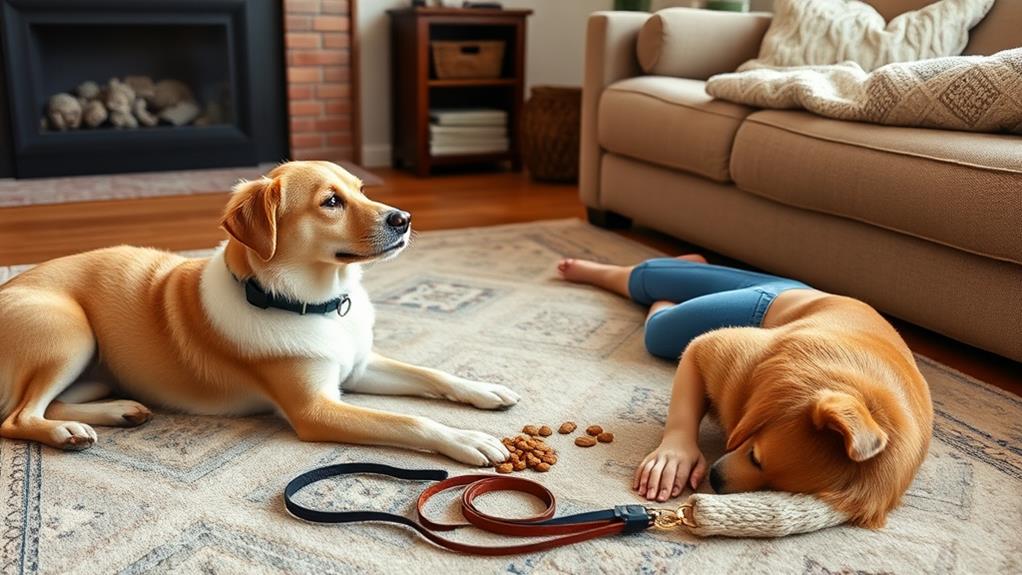You can master essential dog training tips at home by focusing on understanding your dog's behavior and using positive reinforcement. Start with basic commands like "sit," "stay," and "come." Keep sessions short—about 10-15 minutes—and train when your dog is alert. Use treats, praise, or play to reward good behavior, making sure to reward immediately after the action. Consistency is key, so guarantee everyone in your household follows the same training methods. Celebrate small victories to boost your dog's confidence and maintain motivation. Discovering deeper insights will help you train effectively and strengthen your bond with your furry friend.
Understanding Your Dog's Behavior

When you observe your dog closely, you'll start to notice that their behavior communicates a lot about their feelings and needs. For instance, when your dog wags their tail, it often means they're happy and excited. However, a low wagging tail can indicate submission or uncertainty. Pay attention to their body language; a relaxed posture shows comfort, while a stiff stance might signal anxiety or aggression.
You'll also notice how your dog reacts to various situations. If they hide or retreat when meeting new people, they might be feeling overwhelmed. On the other hand, if they approach with a wagging tail and relaxed ears, they're likely feeling friendly and curious. Barking serves as another form of communication: a high-pitched bark can express excitement, while a deep bark might indicate a warning or alertness.
Understanding these subtle cues will deepen your bond with your dog and help you meet their needs more effectively. Remember, every dog is unique, so take the time to learn your pet's specific behaviors and what they signify. This knowledge will empower you to respond appropriately and enhance your dog's overall well-being.
Essential Training Commands

Training your dog to respond to essential commands is crucial for building a strong foundation in your relationship. Start with basic commands like "sit," "stay," "come," and "down." These commands not only help with obedience but also enhance your communication.
Begin with "sit." Hold a treat close to your dog's nose, then move your hand up. As their head follows the treat, their bottom should lower. Once they sit, say "sit" and reward them. For "stay," ask your dog to sit, then open your palm and say "stay." Take a few steps back, and if they stay, reward them.
Next, practice "come." Use a leash for guidance if needed. Say your dog's name followed by "come," and reward them when they approach. Finally, for "down," have your dog sit, then hold a treat in your hand and lower it to the ground. As they follow it down, say "down" and reward them.
Consistency is key. Practice these commands daily, and always reward your dog for their efforts. This won't only improve their responsiveness but also deepen your bond.
Creating a Training Schedule

A consistent training schedule is essential for your dog's success and development. By establishing a routine, you'll help your dog understand when to expect training sessions, making them more focused and engaged. Start by choosing specific times each day for training, ideally when your dog is alert and energetic, like after a walk or playtime.
Aim for short, frequent sessions—about 10 to 15 minutes—so your dog stays motivated without losing interest. Incorporate training into daily activities. For instance, practice commands during walks or feeding times. This not only reinforces learning but also makes it a part of your dog's daily life.
Be flexible, too. Some days might be busier than others, so adjust your schedule as needed. Consistency is key, but it's also okay to adapt based on your dog's progress and energy levels.
Keep track of what you cover in each session, noting any commands that need extra attention. Celebrate small victories, as they build your dog's confidence and strengthen your bond. With a well-structured training schedule, you'll set the foundation for a well-behaved and happy dog.
Positive Reinforcement Techniques

Positive reinforcement techniques are essential for effective dog training, as they encourage desired behaviors through rewards. By using treats, praise, or playtime, you can motivate your dog to repeat good behaviors. Start by identifying what your dog enjoys most; this will help you choose the best rewards.
Here's a simple table to guide you on effective positive reinforcement strategies:
| Reward Type | Example |
|---|---|
| Treat | Small dog biscuits |
| Praise | "Good boy/girl!" |
| Playtime | Fetch or tug-of-war |
When your dog performs a desired action, promptly reward them to reinforce the behavior. Timing is crucial; if you wait too long, your dog may not connect the behavior with the reward. Consistency is key, so use the same commands and rewards during training sessions.
Remember to gradually reduce treats as your dog learns, replacing them with praise or playtime. This shift helps maintain motivation while encouraging your dog to act without expecting a treat every time. With patience and practice, you'll build a strong, trusting bond with your furry friend through positive reinforcement.
Common Training Challenges

Dog owners often encounter common training challenges that can hinder progress and lead to frustration. One major issue is inconsistency. If you don't apply the same commands and rewards every time, your dog may get confused about what you expect. Make sure everyone in your household uses the same cues and follows the same training methods.
Another challenge is distractions. Dogs are naturally curious, and stimuli from the environment can easily divert their attention. Start training in a quiet space before gradually introducing distractions to help your dog learn to focus.
Additionally, some dogs may struggle with certain commands or behaviors, which can be a source of frustration for you both. Patience is key here; don't rush the process. Break down commands into smaller steps and celebrate small victories along the way.
Frequently Asked Questions
How Long Does It Take to Train a Dog at Home?
Training a dog at home usually takes several weeks to months, depending on your dog's age, breed, and temperament. Consistent practice, patience, and positive reinforcement can considerably, markedly speed up the learning process.
What Age Is Best to Start Training a Puppy?
You know what they say, "The early bird catches the worm." Start training your puppy as early as eight weeks. At this age, they're more receptive, avid to learn, and form lasting habits easily.
Can I Train My Dog Without Treats?
Absolutely, you can train your dog without treats! Use praise, toys, or playtime as rewards. Focus on positive reinforcement techniques, and be consistent with commands to build a strong bond and effective training.
How Do I Handle Distractions During Training?
Handling distractions during training means staying calm and focused. Use short sessions, gradually introduce distractions, and reward your dog for maintaining attention. Practice in different environments to help them learn to ignore distractions effectively.
What Equipment Do I Need for Home Training?
For home training, you'll need a quality leash, collar or harness, treats for positive reinforcement, training clicker, and a comfortable mat. These tools will help you create effective and engaging training sessions for your dog.
Conclusion
By mastering these essential dog training tips at home, you're not just teaching commands; you're building a strong bond with your furry friend. Think of it as planting a seed—water it with patience and love, and watch your relationship blossom. Remember, every dog learns at their own pace, so embrace the journey together. With consistency and positive reinforcement, you'll create a harmonious home where both you and your dog thrive. Happy training!



